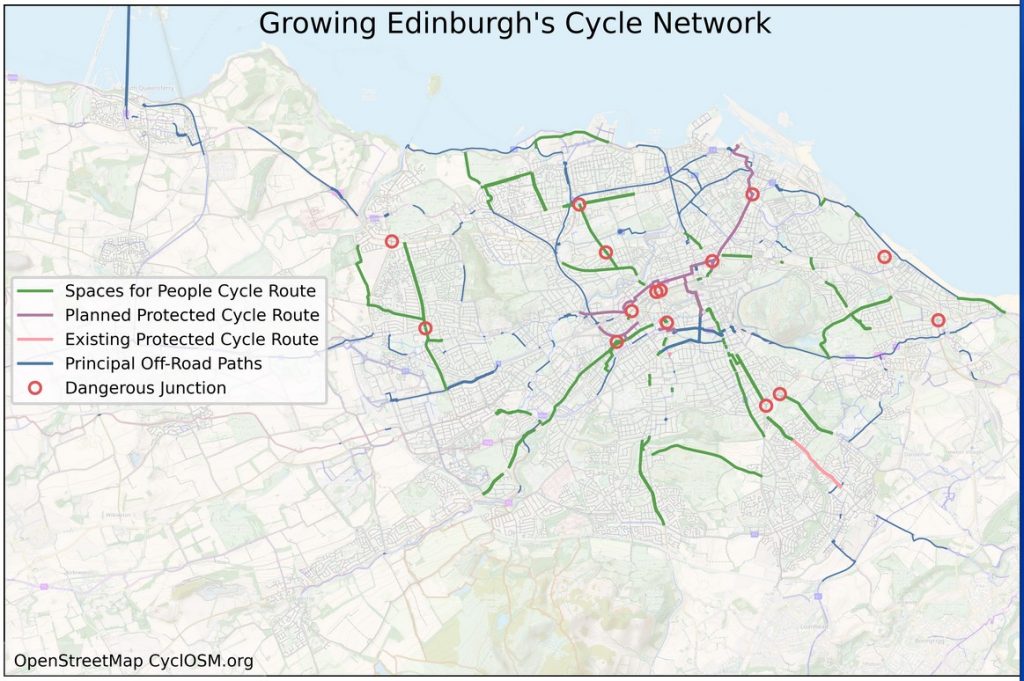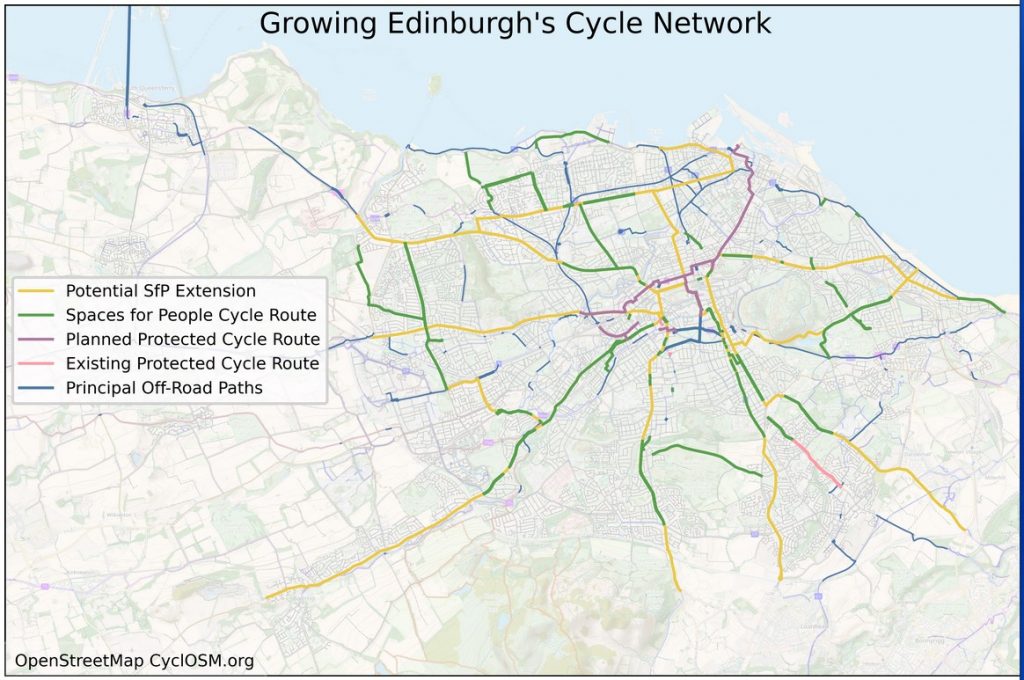[Latest, June 24: Council votes to convert most SfP schemes from ‘temporary’ Traffic Orders (TTRO) to ‘experimental’ (ETRO), as a step to becoming permanent if successful. Sadly, town centre schemes largely excluded]
Until 2019 Edinburgh cycle projects were often isolated schemes, taking advantage of local opportunities or needs, but not joined up. And, many took literally years – or never! – to implement. In contrast, largely designed and implemented in a mere 12 months from Spring 2020, the Spaces for People (SfP) initiative now provides the basis for a properly connected network.
SfP was of course a Scotland-wide government-funded scheme to assist safe outdoor exercising on foot and by bike and to enable more social distancing, including freeing up spaces on public transport. Nonetheless SfP also supports other government and local authority objectives, to increase use of active travel for reasons including climate, public health, and congestion.
For these reasons, top politicians have said that successful SfP schemes should be made permanent rather than being scrapped if and when the need for social distancing ends [see this article for links]. Such comments range right across political parties at the Scottish Parliament, from the Cabinet Secretary for Transport, Michael Matheson MSP, through to Conservative Transport spokesperson, Graham Simpson MSP. Albeit that some local politicians disagree about making schemes permanent.
More formally, the government’s Strategic Transport Projects Review [STPR2] states, “making these (SfP schemes) permanent where successful is the next key step in .. roadspace .. allocation & supporting active travel”
SfP cycling infrastructure in Edinburgh
On June 17, Edinburgh Council’s Transport Committee will debate the future of SfP in the city, following a major city-wide consultation. We have no advance knowledge of what will be in the report, but we hope that Councillors will follow the Cabinet Secretary’s lead and ensure a “permanent lasting legacy” by retaining, enhancing and building on the existing SfP infrastructure.
In terms of cycling infrastructure, Edinburgh’s SfP schemes, together with other planned segregated routes and the existing major offroad routes, form the basis of a potential network, as map 1 below shows. SfP alone has developed several largely complete routes linking local centres with the city centre.
Spokes has conducted bike counts on four SfP corridors, at various times and days. Whilst our volunteer efforts cannot undertake widespread analysis, the results suggest that SfP cycling infrastructure is used consistently throughout the week, even in rainy weather. Even at the least-cycled location, in the rain, outside commuter time, a bike passed every 4 minutes; whilst at the most-cycled time/location there was one bike every 30 seconds.
Of course, being small and quiet, compared to the noise and visual impact of a motor vehicle, bikes can easily be discounted or not noticed. Yet, despite its relatively small roadspace requirement, a bike is often transporting just as much in terms of people and luggage as a typical passing car – indeed our traffic counts suggest that over 75% of city-centre rush-hour cars, despite their major roadspace demand, have only one occupant.
Our full count results also dispel any notion of most bike users on Edinburgh’s roads being ‘mamils.’ On weekdays, only 11% of those counted were in lycra/road-bike gear, and even on Saturday morning only 28% – a high proportion of these being on Comiston Road, presumably for Pentlands/Midlothian rides.
Notes to the table
- All locations counted bikes in both directions
- Gender split was estimated at approx 33% female, except nearly 50% on Crewe Rd South
- ‘Sporty’ cyclists (lycra + road bike etc) were estimated at 28% on Saturday, 11% weekday
- The other roughly 72%/89% were classed as “ordinary clothes, cycling as transport”
- Several cargo bikes were seen, mainly at the Forrest Road counts
Next steps : enhancing and linking up the network
The SfP schemes had to be introduced very rapidly, given that their purpose was around the pandemic. Added to that, a condition of the government SfP cash was that it had to be spent by mid May 2021 (with a few limited extensions). Sadly, because of the government cash cut-off date, a small number of planned schemes, notably Portobello-Musselburgh, were taken out of SfP and can now only go ahead if and when funded in some other way.
Overall, however, it is astonishing how much was achieved (as also in Glasgow) in just one year, when SfP was totally unexpected and not in any Council’s forward planning. Edinburgh has installed schemes from pavement extensions to road closures at some 70 schools, 40km of semi-segregated cycleroute, several traffic-reduced areas, and many widened footways in town centres.
Given the extent and speed of installation, and the experience and feedback now gained, many potential improvements and enhancements can now be identified. These fall into 3 categories…
- Adding further links so that the SfP schemes, together with other existing and planned safe cycle routes, form a coherent basic city cycle network, for example as in map 2 below
- Tackling dangerous junctions on the network – a task which, with a few exceptions, was not possible during the SfP year given the constraints of staffing and of time. Junctions which Spokes has identified as particularly dangerous are shown in map 1 above, but removed in the map 2 basic network below
- Thoroughly assessing all existing schemes on the basis of experience so far. Our Spokes submission to the recent Spaces for People consultation included an appendix describing the type of issues which need addressed – many of which can be done in the short term, others in the longer term as schemes are gradually redesigned with more permanent materials as in the York Place route.
Cash for Growing and Enhancing the Network
Whilst there is never enough cash, active travel capital funding from the Scottish Government is looking more positive than ever before. After years hovering around £20m and then £40m per year, it has, in the last couple of years, risen to £100m (without which Spaces for People itself might never have happened) and now £115m.
Moreover, although the Holyrood 2021 SNP election manifesto promised the smallest rise of any main party, the rise is nonetheless substantial, so that, by the end of the Parliament, active travel will receive 10% of transport capital expenditure. This is equivalent to about 7% of total transport spending, compared to just 3.5% now. Given that the Green Party had promised 10% of total transport spending immediately, and is in a position of influence, we can realistically hope that much or all of the SNP’s increase will come in the early years of the new Parliament – and may indeed rise further.
Thus whilst the £40m allocated to SfP last year caused cash-flow problems for a few non-SfP schemes, Councils with high quality active travel proposals can expect increasing allocations from now on. Edinburgh is in a particularly good place to bid for very significant government cash for network extension and enhancement, since it can offer the requisite match-funding through its own 10% cycle cash commitment.
Future wider network
In the future, as more government cash becomes available, and as the City Mobility Plan is implemented, the network can grow further, in particular with routes between local centres rather than just into the city centre, and with more local connections. Map 3 is an indication of the way in which this could develop.
More information
- We hope to publish more detail for above maps at a later date, including selecting particular layers, or watch an animation of the network growing
- Please note that our suggested network enhancements and extensions are just that – suggestions. They indicate the kind of way that the network could develop but we are not presenting this as fully analysed ‘perfect’ solution
- Powerpoint by John Robson on same theme as article
- Please retweet our tweet about this article
Some random SfP users – click to see larger size
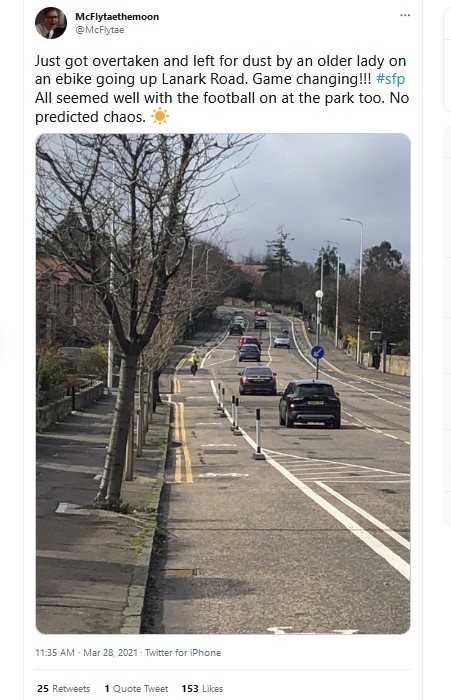
Lanark Rd 
Meadows-Greenbank 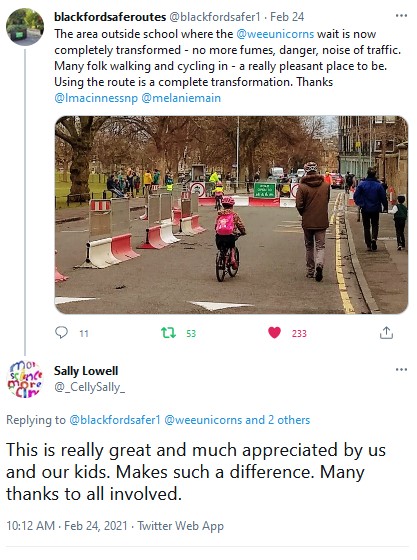
Meadows-Greenbank 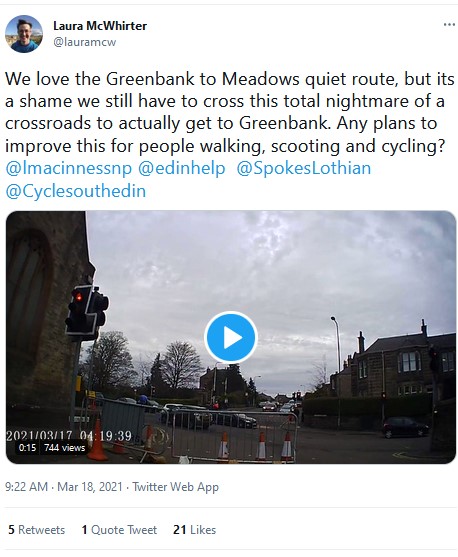
Meadows-Greenbank 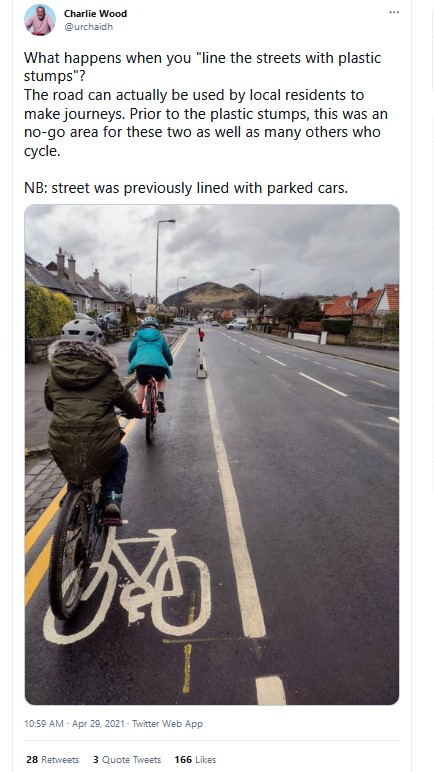
Duddingston 
Drum Brae 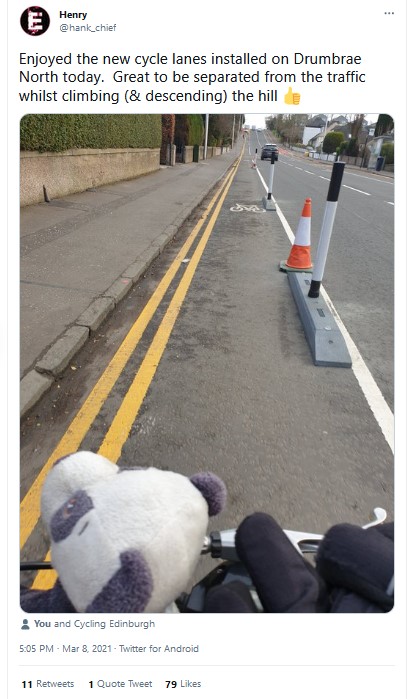
Drum Brae 
Drum Brae 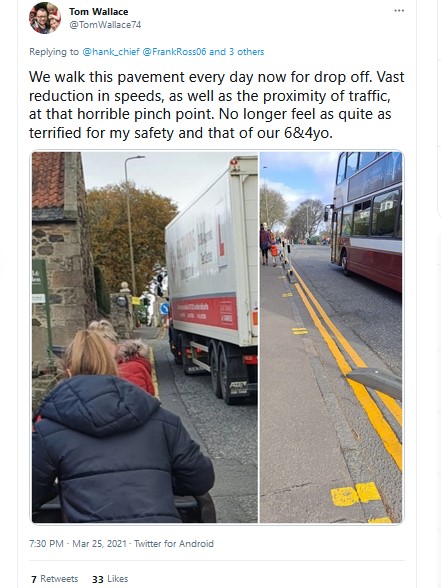
Corstorphine, footway scheme 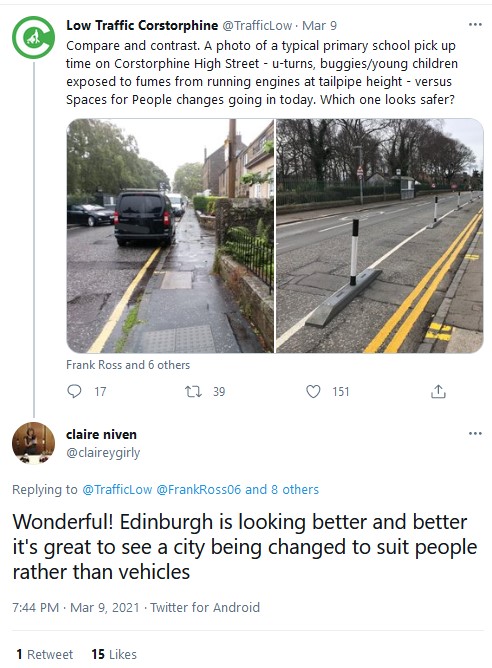
Corstorphine, footway scheme 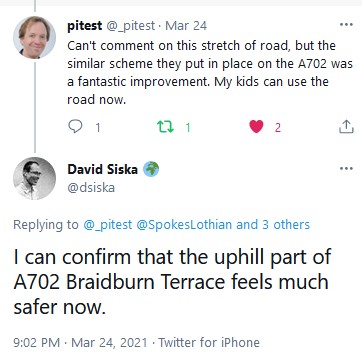
Comiston Rd 
Comiston Rd 
Comiston Rd 
Bruntsfield, footway scheme 
Silverknowes 
Queensferry Rd 
Mayfield 
Links Gardens 
Lanark Road 
the commute 
the old 
the young



